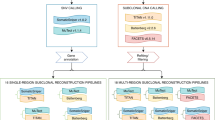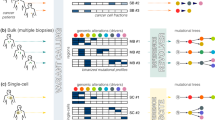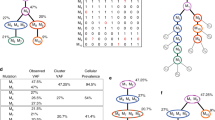Abstract
Given the implications of tumor dynamics for precision medicine, there is a need to systematically characterize the mode of evolution across diverse solid tumor types. In particular, methods to infer the role of natural selection within established human tumors are lacking. By simulating spatial tumor growth under different evolutionary modes and examining patterns of between-region subclonal genetic divergence from multiregion sequencing (MRS) data, we demonstrate that it is feasible to distinguish tumors driven by strong positive subclonal selection from those evolving neutrally or under weak selection, as the latter fail to dramatically alter subclonal composition. We developed a classifier based on measures of between-region subclonal genetic divergence and projected patient data into model space, finding different modes of evolution both within and between solid tumor types. Our findings have broad implications for how human tumors progress, how they accumulate intratumoral heterogeneity, and ultimately how they may be more effectively treated.
This is a preview of subscription content, access via your institution
Access options
Access Nature and 54 other Nature Portfolio journals
Get Nature+, our best-value online-access subscription
$29.99 / 30 days
cancel any time
Subscribe to this journal
Receive 12 print issues and online access
$209.00 per year
only $17.42 per issue
Buy this article
- Purchase on Springer Link
- Instant access to full article PDF
Prices may be subject to local taxes which are calculated during checkout






Similar content being viewed by others
Accession codes
References
Nordling, C.O. A new theory on cancer-inducing mechanism. Br. J. Cancer 7, 68–72 (1953).
Armitage, P. & Doll, R. The age distribution of cancer and a multi-stage theory of carcinogenesis. Br. J. Cancer 8, 1–12 (1954).
Nowell, P.C. The clonal evolution of tumor cell populations. Science 194, 23–28 (1976).
Cairns, J. Mutation selection and the natural history of cancer. Nature 255, 197–200 (1975).
Fearon, E.R. & Vogelstein, B. A genetic model for colorectal tumorigenesis. Cell 61, 759–767 (1990).
Tsao, J.L. et al. Genetic reconstruction of individual colorectal tumor histories. Proc. Natl. Acad. Sci. USA 97, 1236–1241 (2000).
Tomasetti, C., Vogelstein, B. & Parmigiani, G. Half or more of the somatic mutations in cancers of self-renewing tissues originate prior to tumor initiation. Proc. Natl. Acad. Sci. USA 110, 1999–2004 (2013).
Hu, Z., Sun, R. & Curtis, C. A population genetics perspective on the determinants of intra-tumor heterogeneity. Biochim. Biophys. Acta http://dx.doi.org/10.1016/j.bbcan.2017.03.001 (2017).
Vogelstein, B. et al. Cancer genome landscapes. Science 339, 1546–1558 (2013).
Nik-Zainal, S. et al. The life history of 21 breast cancers. Cell 149, 994–1007 (2012).
Fischer, A., Vázquez-García, I., Illingworth, C.J. & Mustonen, V. High-definition reconstruction of clonal composition in cancer. Cell Reports 7, 1740–1752 (2014).
Roth, A. et al. PyClone: statistical inference of clonal population structure in cancer. Nat. Methods 11, 396–398 (2014).
Miller, C.A. et al. SciClone: inferring clonal architecture and tracking the spatial and temporal patterns of tumor evolution. PLOS Comput. Biol. 10, e1003665 (2014).
Deshwar, A.G. et al. PhyloWGS: reconstructing subclonal composition and evolution from whole-genome sequencing of tumors. Genome Biol. 16, 35 (2015).
Sottoriva, A. et al. A Big Bang model of human colorectal tumor growth. Nat. Genet. 47, 209–216 (2015).
Uchi, R. et al. Integrated multiregional analysis proposing a new model of colorectal cancer evolution. PLoS Genet. 12, e1005778 (2016).
Sievers, C.K. et al. Subclonal diversity arises early even in small colorectal tumours and contributes to differential growth fates. Gut http://dx.doi.org/10.1136/gutjnl-2016-312232 (2016).
Bozic, I., Gerold, J.M. & Nowak, M.A. Quantifying clonal and subclonal passenger mutations in cancer evolution. PLOS Comput. Biol. 12, e1004731 (2016).
Suzuki, Y. et al. Multiregion ultra-deep sequencing reveals early intermixing and variable levels of intratumoral heterogeneity in colorectal cancer. Mol. Oncol. 11, 124–139 (2017).
Ling, S. et al. Extremely high genetic diversity in a single tumor points to prevalence of non-Darwinian cell evolution. Proc. Natl. Acad. Sci. USA 112, E6496–E6505 (2015).
Williams, M.J., Werner, B., Barnes, C.P., Graham, T.A. & Sottoriva, A. Identification of neutral tumor evolution across cancer types. Nat. Genet. 48, 238–244 (2016).
Bustamante, C.D., Wakeley, J., Sawyer, S. & Hartl, D.L. Directional selection and the site-frequency spectrum. Genetics 159, 1779–1788 (2001).
Ray, N., Currat, M. & Excoffier, L. Intra-deme molecular diversity in spatially expanding populations. Mol. Biol. Evol. 20, 76–86 (2003).
Siegmund, K. & Shibata, D. At least two well-spaced samples are needed to genotype a solid tumor. BMC Cancer 16, 250 (2016).
Holsinger, K.E. & Weir, B.S. Genetics in geographically structured populations: defining, estimating and interpreting FST . Nat. Rev. Genet. 10, 639–650 (2009).
Durrett, R. Population genetics of neutral mutations in exponentially growing cancer cell populations. Ann. Appl. Probab. 23, 230–250 (2013).
Kimura, M. Model of effectively neutral mutations in which selective constraint is incorporated. Proc. Natl. Acad. Sci. USA 76, 3440–3444 (1979).
Ohta, T. & Gillespie, J.H. Development of neutral and nearly neutral theories. Theor. Popul. Biol. 49, 128–142 (1996).
Rowan, A. et al. Refining molecular analysis in the pathways of colorectal carcinogenesis. Clin. Gastroenterol. Hepatol. 3, 1115–1123 (2005).
Qiao, Y. et al. SubcloneSeeker: a computational framework for reconstructing tumor clone structure for cancer variant interpretation and prioritization. Genome Biol. 15, 443 (2014).
Li, B. & Li, J.Z. A general framework for analyzing tumor subclonality using SNP array and DNA sequencing data. Genome Biol. 15, 473 (2014).
Popic, V. et al. Fast and scalable inference of multi-sample cancer lineages. Genome Biol. 16, 91 (2015).
Ross-Innes, C.S. et al. Whole-genome sequencing provides new insights into the clonal architecture of Barrett's esophagus and esophageal adenocarcinoma. Nat. Genet. 47, 1038–1046 (2015).
Zhang, J. et al. Intratumor heterogeneity in localized lung adenocarcinomas delineated by multiregion sequencing. Science 346, 256–259 (2014).
de Bruin, E.C. et al. Spatial and temporal diversity in genomic instability processes defines lung cancer evolution. Science 346, 251–256 (2014).
Johnson, B.E. et al. Mutational analysis reveals the origin and therapy-driven evolution of recurrent glioma. Science 343, 189–193 (2014).
Kim, H. et al. Whole-genome and multisector exome sequencing of primary and post-treatment glioblastoma reveals patterns of tumor evolution. Genome Res. 25, 316–327 (2015).
Tajima, F. Statistical method for testing the neutral mutation hypothesis by DNA polymorphism. Genetics 123, 585–595 (1989).
Grossman, S.R. et al. A composite of multiple signals distinguishes causal variants in regions of positive selection. Science 327, 883–886 (2010).
Ostrow, S.L., Barshir, R., DeGregori, J., Yeger-Lotem, E. & Hershberg, R. Cancer evolution is associated with pervasive positive selection on globally expressed genes. PLoS Genet. 10, e1004239 (2014).
Wu, C.-I., Wang, H.-Y., Ling, S. & Lu, X. The ecology and evolution of cancer: the ultra-microevolutionary process. Annu. Rev. Genet. 50, 347–369 (2016).
Messer, P.W. & Petrov, D.A. Population genomics of rapid adaptation by soft selective sweeps. Trends Ecol. Evol. 28, 659–669 (2013).
Lloyd, M.C. et al. Darwinian dynamics of intratumoral heterogeneity: not solely random mutations but also variable environmental selection forces. Cancer Res. 76, 3136–3144 (2016).
McFarland, C.D., Korolev, K.S., Kryukov, G.V., Sunyaev, S.R. & Mirny, L.A. Impact of deleterious passenger mutations on cancer progression. Proc. Natl. Acad. Sci. USA 110, 2910–2915 (2013).
Marusyk, A. et al. Non-cell-autonomous driving of tumour growth supports sub-clonal heterogeneity. Nature 514, 54–58 (2014).
Cleary, A.S., Leonard, T.L., Gestl, S.A. & Gunther, E.J. Tumour cell heterogeneity maintained by cooperating subclones in Wnt-driven mammary cancers. Nature 508, 113–117 (2014).
Cibulskis, K. et al. Sensitive detection of somatic point mutations in impure and heterogeneous cancer samples. Nat. Biotechnol. 31, 213–219 (2013).
Ha, G. et al. TITAN: inference of copy number architectures in clonal cell populations from tumor whole-genome sequence data. Genome Res. 24, 1881–1893 (2014).
Waclaw, B. et al. A spatial model predicts that dispersal and cell turnover limit intratumour heterogeneity. Nature 525, 261–264 (2015).
Diaz, L.A. Jr. et al. The molecular evolution of acquired resistance to targeted EGFR blockade in colorectal cancers. Nature 486, 537–540 (2012).
Bozic, I. et al. Accumulation of driver and passenger mutations during tumor progression. Proc. Natl. Acad. Sci. USA 107, 18545–18550 (2010).
Visvader, J.E. & Lindeman, G.J. Cancer stem cells in solid tumours: accumulating evidence and unresolved questions. Nat. Rev. Cancer 8, 755–768 (2008).
Wand, M.P. Data-based choice of histogram bin width. Am. Stat. 51, 59 (1997).
Bhatia, G., Patterson, N., Sankararaman, S. & Price, A.L. Estimating and interpreting FST: the impact of rare variants. Genome Res. 23, 1514–1521 (2013).
Kuhn, M. Building predictive models in R using the caret package. J. Stat. Softw. 28, 1–26 (2008).
Acknowledgements
This work was funded by awards from the NIH (R01CA182514), the Susan G. Komen Foundation (IIR13260750), and the Breast Cancer Research Foundation (BCRF-16-032) to C.C. and an award from the NIH (R01CA185016) to D.S. Z.H. is supported by an Innovative Genomics Initiative (IGI) Postdoctoral Fellowship. A.S. is supported by the Chris Rokos Fellowship. T.A.G. was supported by Cancer Research UK. This work was supported in part by NIH P30 CA124435 using the Genetics Bioinformatics Service Center within the Stanford Cancer Institute Shared Resource. The results are in part based upon data generated from the following studies: EGAD00001001394, EGAD00001000714, EGAD00001000900, EGAD00001000984, and EGAD00001001113. We thank members of the Curtis laboratory for helpful discussions.
Author information
Authors and Affiliations
Contributions
R.S., Z.H., and C.C. designed the study. R.S. analyzed and visualized the data and performed statistical analyses. Z.H. performed simulation studies. Z.M. and D.S. generated data. R.S., Z.H., and C.C. interpreted the data. A.S. and T.A.G. contributed to earlier analysis of the COAD data set. A.H. provided statistical advice. J.M.F. performed xenograft experiments. D.S. and C.C. provided reagents and data. C.C. supervised the study and wrote the manuscript with input from R.S. and Z.H. All authors read and approved the final manuscript.
Corresponding author
Ethics declarations
Competing interests
The authors declare no competing financial interests.
Supplementary information
Supplementary Text and Figures
Supplementary Figures 1–36, Supplementary Tables 1–3 and Supplementary Note. (PDF 20850 kb)
Supplementary Table 4
SFS-derived ITH metrics for virtual tumors. (XLSX 303 kb)
Supplementary Table 5
SFS-derived ITH metrics and SVM-based classification of patient samples. (XLSX 18 kb)
Rights and permissions
About this article
Cite this article
Sun, R., Hu, Z., Sottoriva, A. et al. Between-region genetic divergence reflects the mode and tempo of tumor evolution. Nat Genet 49, 1015–1024 (2017). https://doi.org/10.1038/ng.3891
Received:
Accepted:
Published:
Issue Date:
DOI: https://doi.org/10.1038/ng.3891
This article is cited by
-
Evolving copy number gains promote tumor expansion and bolster mutational diversification
Nature Communications (2024)
-
Tumor phylogeography reveals block-shaped spatial heterogeneity and the mode of evolution in Hepatocellular Carcinoma
Nature Communications (2024)
-
Tumour Growth Mechanisms Determine Effectiveness of Adaptive Therapy in Glandular Tumours
Interdisciplinary Sciences: Computational Life Sciences (2024)
-
Deterministic evolution and stringent selection during preneoplasia
Nature (2023)
-
State-dependent evolutionary models reveal modes of solid tumour growth
Nature Ecology & Evolution (2023)



